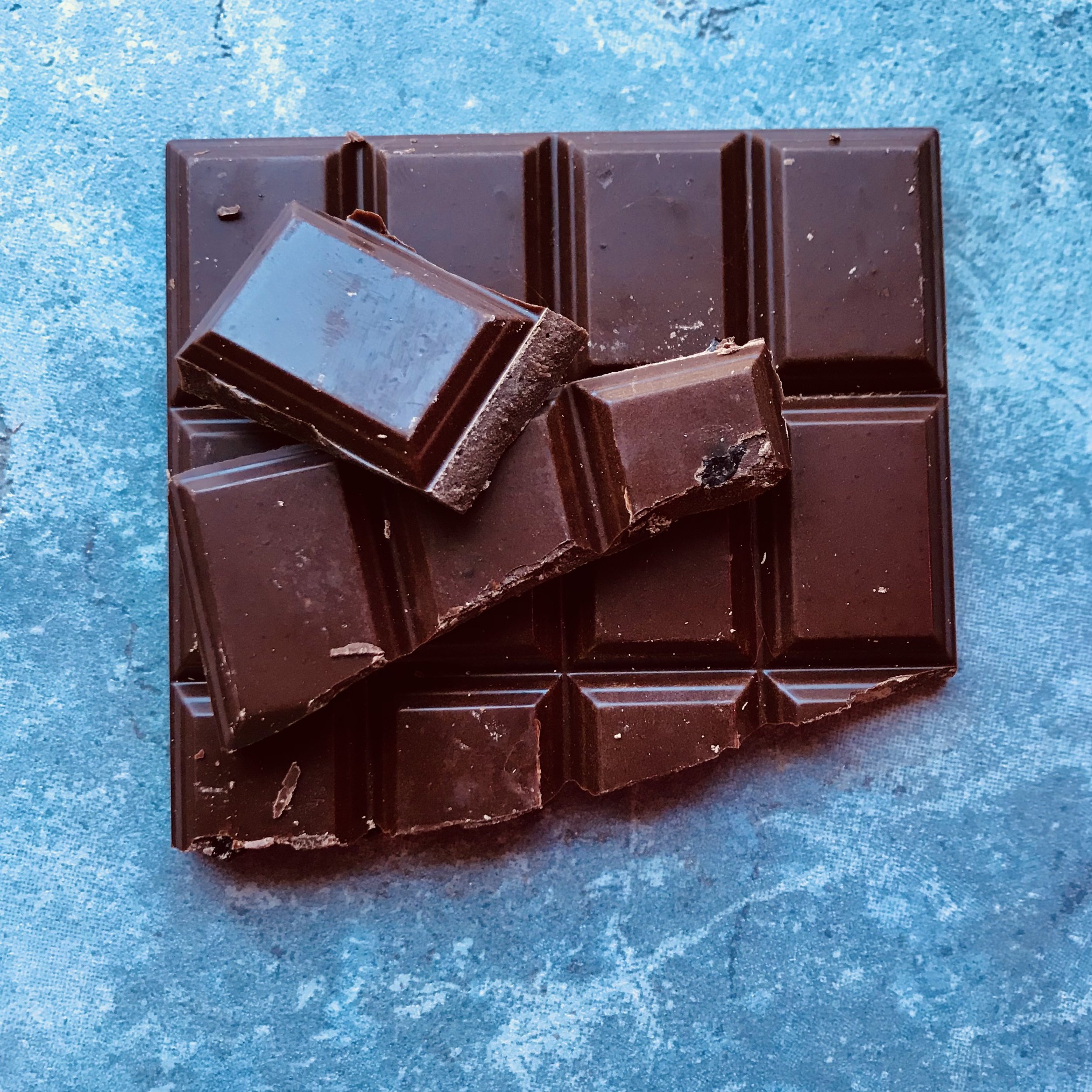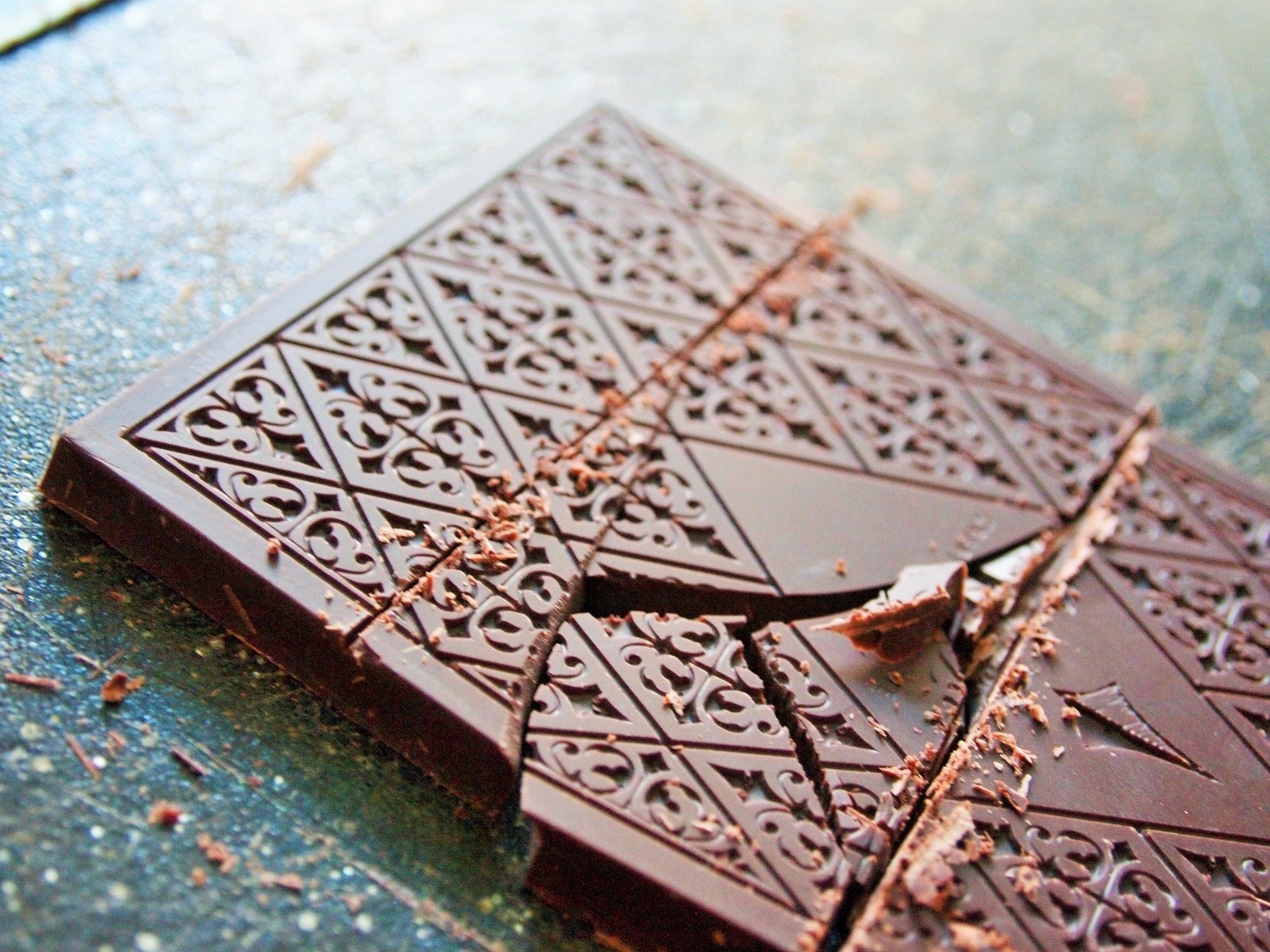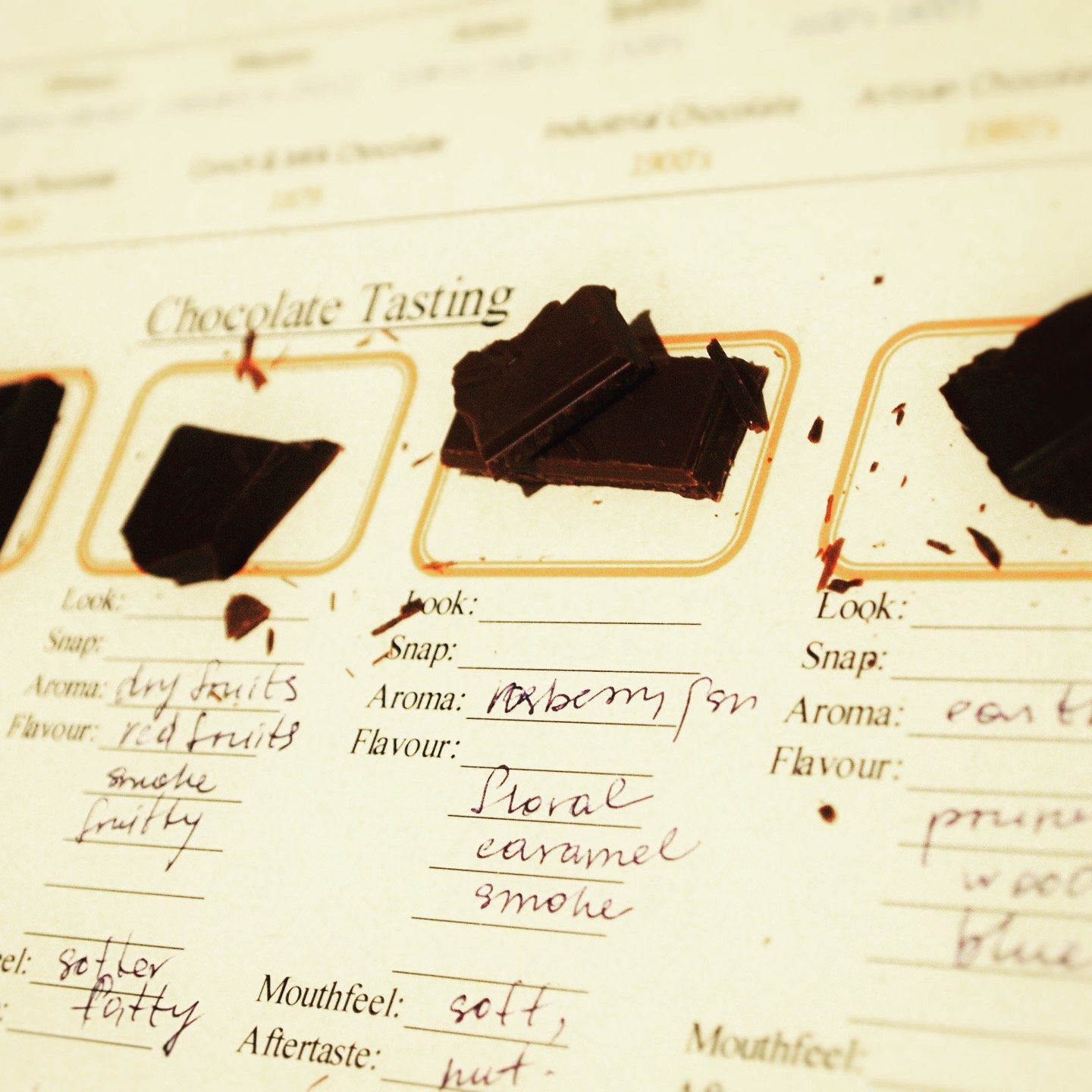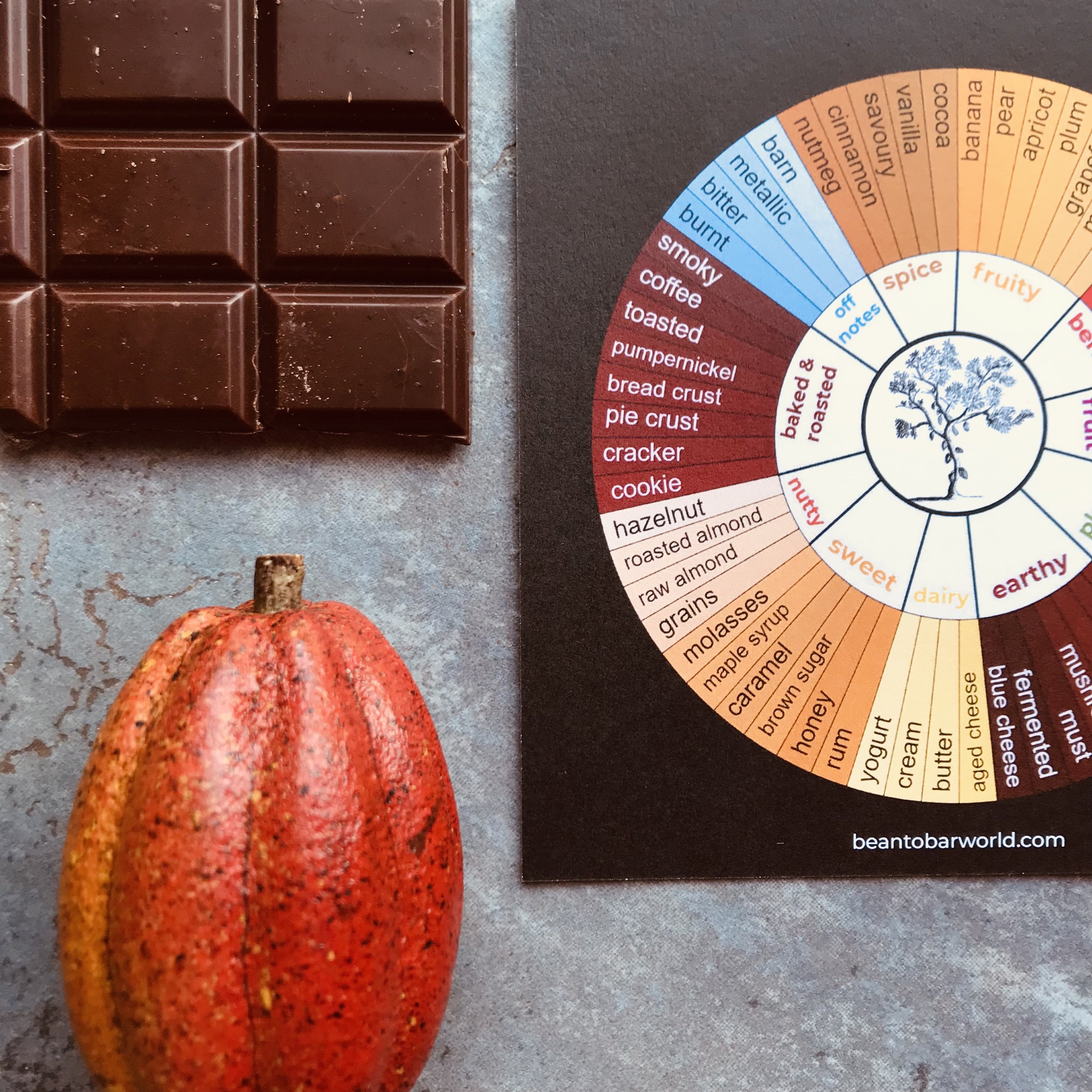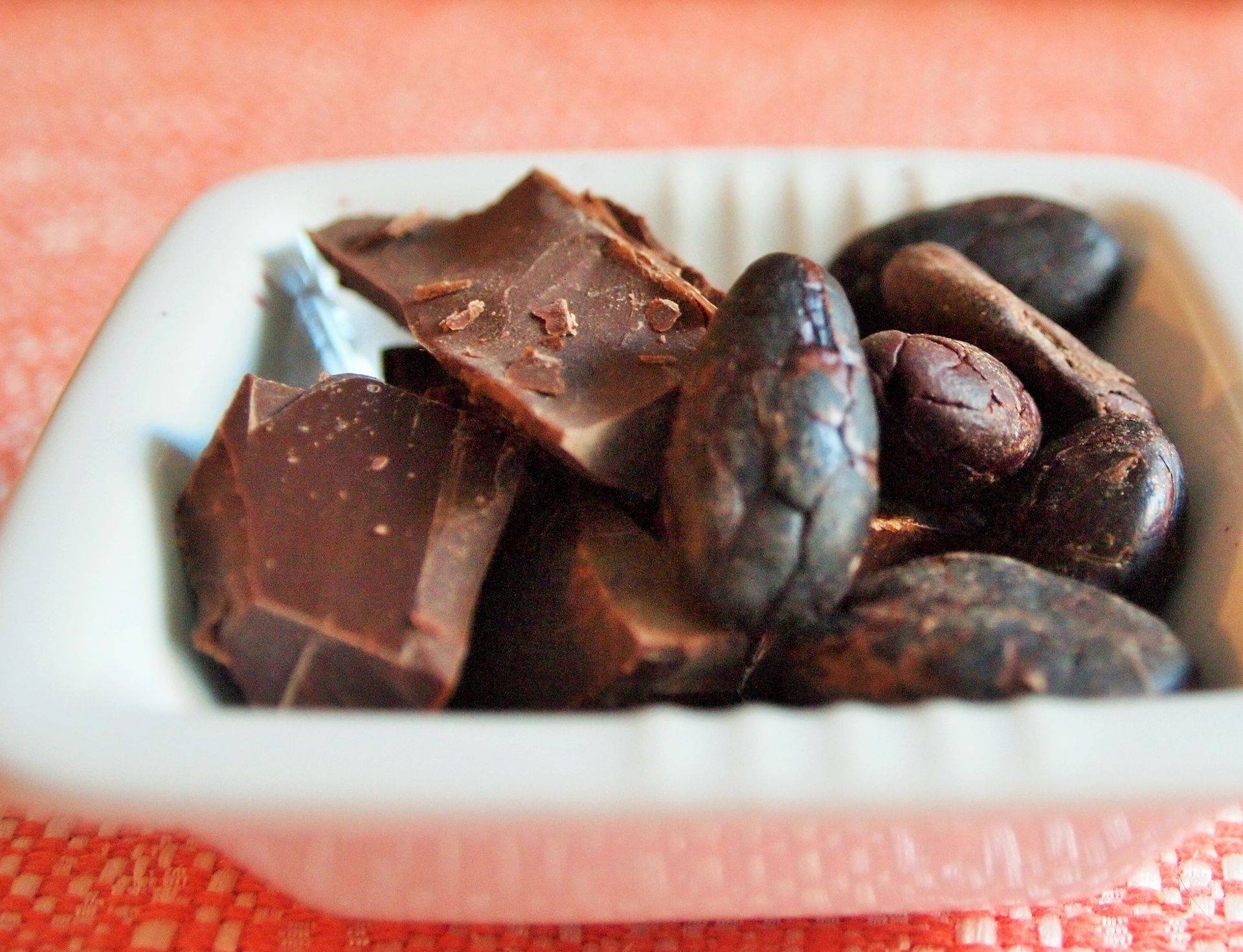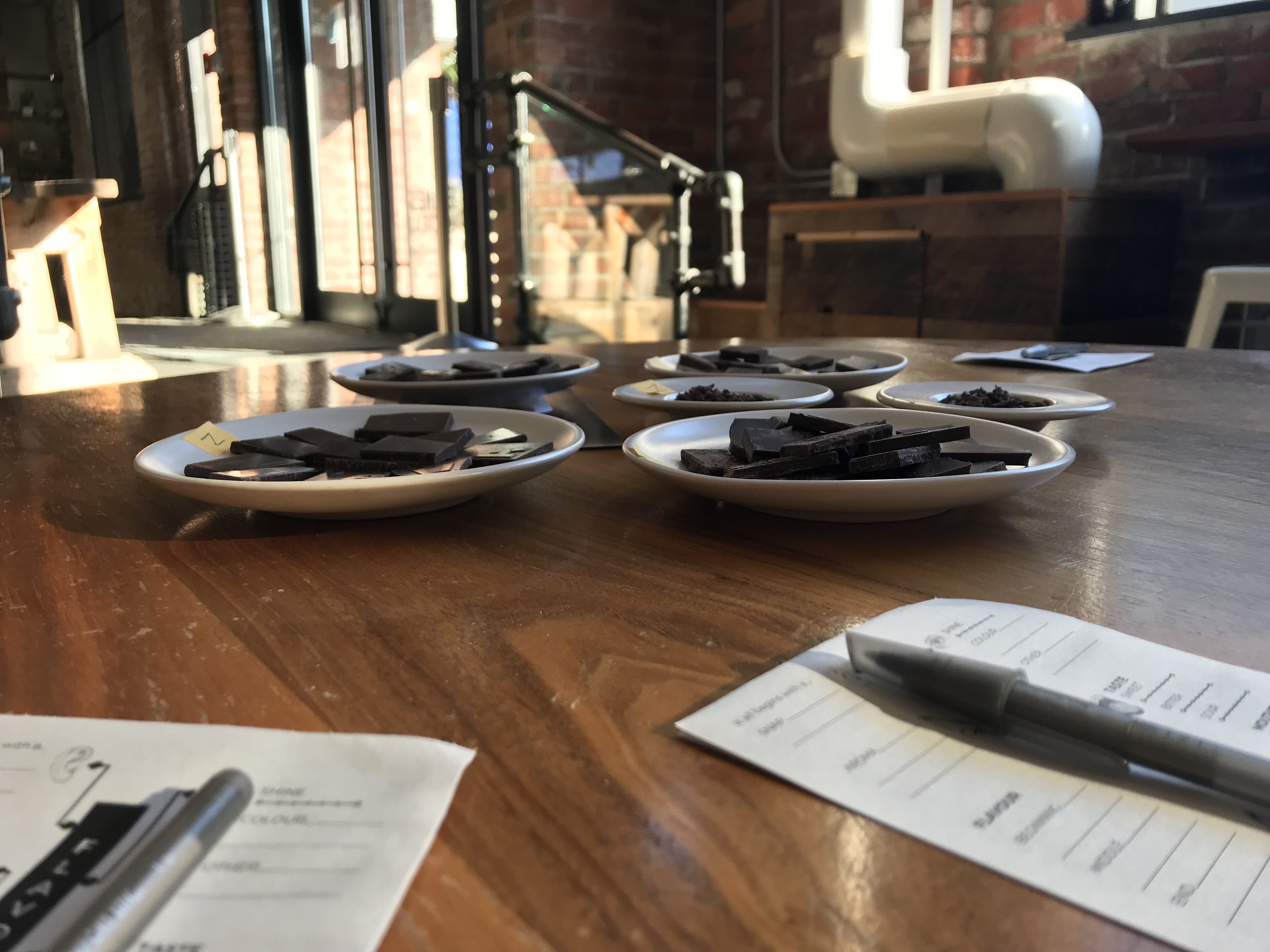What is chocolate tasting about?
Many people are unaware that fine dark chocolate has even more variance in flavour than fine coffee, wine, and other fine drinks and foods. This doesn’t include bonbons with flavoured ganaches. I’m talking about plain dark chocolate made with only cocoa beans, sugar, and maybe some extra cocoa butter; no vanilla, no other flavour enhancers, and no other ingredients.
If you are tasting notes of cherry, oak, or caramel in your plain dark fine chocolate, these flavours were not added with ingredients or flavour enhancers. These flavours come from the cocoa bean itself and how it was cured and turned into chocolate.
If you are new to fine chocolate, know that all the chocolate you have had in your life was made from pretty much the same type of bean, which produced the typical cocoa/chocolate flavour you have grown up with. The truth of the mater is, there is a much wide spectrum of flavour when it comes to fine pure dark chocolate. Sometimes, it doesn’t even taste like the “chocolate” at all!
Welcome!
+ Where does this variance in fine chocolate flavour come from?
There are many factors which influence the final flavour of plain dark chocolate, but the four major contributors are: genetics of the trees, the fermentation of the seeds, the roasting of the seeds, and the refining/grinding of the seeds into chocolate.
Genetics
Genetics dictates the building blocks of potential flavour. A tree which produces bitter seeds with a low variance in flavour, or only a typical cocoa flavour, it's not going to have much potential in developing an interesting range of other flavours beyond cocoa. Starting with cocoa beans that have potential for good flavour is a great start, but how these beans are treated will determine how good a result one achieves. And when I say genetics, I'm not just talking about the variety of the cacao tree. Within a variety itself there is great variance. Cacao trees of the same or similar variety may produce seeds of various flavours. Even individual trees within a cacao farm can produce seeds and fruits with very unique qualities.
Fermentation
The seeds and the fruit around them are fermented. However, it is the fruit that goes through the fermentation process, not the seed. The seed is impacted by the results of the fermentation. Normally, the fruit and seeds are spontaneously inoculated by local yeasts and bacteria. This fermentation is controlled in regards to temperature of the mass (kept around 50°C, and duration of fermentation (3-7 days). The fruit disintegrates, but the metabolites from the lactic acid bacteria and acetic acid bacteria which developed on the fruit act on the seed. There is a tiny hole at one end of the cocoa bean husk, and these metabolites enter around the kernel of the seed and break down carbohydrates to reducing sugars, and proteins to amino acids and peptides.
These smaller versions of carbohydrates and proteins will play their part during roasting to develop aroma molecules. If we don't ferment our seeds, they will end up more bitter, harsh, and lack the capacity to build some interesting flavour aromas later on during roasting.
Fermentation is a key step to curing the seed, and directing it flavour wise to something quite wonderful. Keep in mind that some studies suggest that even the species of yeasts and bacteria can alter to some degree the flavour profile of the post-fermented seeds. As well, some farmers have experimented with adding other local fruits to the fermentation of the seeds. The cacao fruit mixed with other types of fruits have also altered the flavour of the post-fermented seed.
Fermentation can have a very big impact on the final flavour of the seed, which in turn will impact the final flavour of the chocolate.
Roasting
Just as with coffee beans, experimenting with roasting of the cocoa beans can greatly influence the flavour profile of the bean before its ground up and turned into chocolate. The temperature, duration, and humidity during roasting can all impact which aroma molecules are burned off or created. Certain types of aromas such as alcohols, esters, pyrazines, and so on require different temperatures to be formed within the kernel of the seed.
Roasting too high a temperature can burn the beans or burn off some of the more delicate flavour aromas created at a slightly lower temperature. Roasting too low a temperature will impede the production of some aroma molecules, and may also leave behind unwanted aromas such as acidic acid from the fermentation stage which is cooked off during roasting.
Refining/melanging/grinding
Whatever you want to call it, refining the now roasted cocoa nibs will have a huge impact on the final flavour of the chocolate. Many new bean to bar makers focus too much on roasting, and not enough on refining. Refining chocolate can go from 36 hours to 72 hours of not stop grinding in the refiner. Not only does this smooth out the chocolate, but it actually transforms the overall flavour profile of the chocolate. Some aromas are released out of the chocolate, and some may even be formed during refining. The same batch of chocolate can taste very different from 12 hours, to 36 hours, to 72 hours of refining. This stage is most often underestimated when it comes to explaining to people why and how fine dark chocolate has such unique flavour profiles.
+ Why is fine chocolate often compared to fine drinks, not foods?
It’s interesting that we compare chocolate to other drinks instead of other foods, but keep in mind that when chocolate was created it was a drink as well, for over 5000 years. Chocolate as we know it today, mostly in solid form, has only been around 170 years. Chocolate, just like coffee and black tea, was a dark coloured water based drink, and remained this way for thousands of years.
Just as you would discover natural flavour notes of cherry, vanilla, or caramel in fine drinks such as coffee, wine, or whiskey, you can also find these and more in single origin dark chocolate. Just as the flavours of these drinks can be impacted by the main ingredient and how it was processed, the same is true for chocolate. Again, these flavours are not ingredients or flavourings added to it, but rather created and brought out from the way the bean was cured and processed into chocolate. Very similar to wine, coffee, whiskey, etc.
+ I’ve tried fine chocolate, and I don’t notice a difference.
Yes, I've heard that many times, and don't worry you're not alone. If you tried fine chocolate before, there could be a few reasons why you couldn't taste anything beyond "chocolate".
It wasn't fine chocolate
You smoke, have a stuffed nose, allergies, or recently lost your sense of smell/taste.
You didn't know what to taste for.
Keep in mind that the mechanisms behind flavour (or "taste" some may call it) is one of the least researched and studied of the 5 senses. We don't know as much about it, and so this has created a recycling of information based on theories, speculations, and outdated reasoning.
Keep in mind that flavour is not something contained in our food. It also is not just a combination of taste and smell. Flavour is a perception in the brain that combines all our senses. Also keep in mind you and I have different genetics, and because of that have different types and numbers of taste receptors in our mouth, and different olfactory receptors in our note. Therefore, each of us can be "tasting" things a little differently without knowing it. As well, since flavour is a perception formed in the brain, it combines what we taste/smell/see/feel/hear with previous ideas, foods, smells, that we have in our brain to conclude on what it is we are "tasting" (or more precisely what the flavour is) in our chocolate.
That said, don't feel intimidated or as though you are "not good at tasting" because what you taste is different than the person next to you, an "expert", or the suggested flavours on the label of the bar.
In every single tasting I have had, many people will agree that the chocolate is fruity, but have different specifics about what type of fruit it reminds them of. As well, there is always one or two people in the group who don't taste fruit at all, and have something completely different in mind. Some of this is due to lack of experience in the case of beginners, but some of it is due to physical differences in our bodies, as well as the way our brains concluded on all this information! Flavour is complex.
+ How do we know other flavourings were not added?
By law in most countries, makers would have to label if they added other ingredients, or "natural" or artificial flavours.
A fine dark chocolate should not only have a wide range of various beginning, middle, and notes, but should also have no added flavours or ingredients to it. Not even vanilla. You wouldn't add espresso extract or vanilla to a fine espresso. And you wouldn't want to find out there was fruit juice added to your wine to make it better. No. A fine food product such as chocolate is no different than coffee or wine, in that its flavour comes from the main ingredient.
I guess the only 100% sure way to know would be to make fine dark chocolate yourself from the bean. Use different cacao beans, and refine them with just a little bit of sugar. If done right, you will be amazed how two chocolates made with the exact same ingredients (aside from different types of cacao) can taste so different from one another.
+ Why do tastings focus on dark chocolate?
This has to do with the fact that chocolate is all about the cocoa bean. Dark chocolate is in a way the espresso of the chocolate world. If you want to really appreciate the essence of the bean itself and what it has to offer, then you don't want to add any other ingredients to interfere.
Of course, just like with coffee you can add milk and enjoy it as well. However, to really appreciate the quality of the bean, and the quality of the chocolate, and to understand the essence of what fine chocolate is about, one needs to understand and taste plain dark chocolate made with different cocoa beans.
Usually this is my litmus test to determine how skilled a bean to bar chocolate maker is. If they can produce one or a few incredible interesting plain dark chocolates, then I can trust they are a skillful maker who knows what they are doing. They know how to select the right beans, and also how to roast and refine it to perfection. Some makers out there do an okay job on their dark chocolate, but an incredible job on their milk and flavoured chocolate bars. That's great, but as far as skill level, they have a ways to go. Part of endeavouring into any fine food (or any craft) is the ability to appreciate skill and talent, and to encourage it with our support monetarily and emotionally.
+ Can I do a tasting with milk chocolate?
Of course! You can do a plain dark chocolate tasting, just as you would an espresso tasting, to focus on the essence of the bean itself and the talent of the maker.
In the same way you can also enjoy lattes and cappuccinos, you can also enjoy milk chocolate. They are essentially the lattes and cappuccinos of the chocolate world. The difference being the milk as the major flavouring ingredient added. You won't capture the entire essense of just the bean, but that's okay! Some suggest that adding milk to lattes or chocolate defeats the purpose of using fine coffee or cocoa beans. This is not the case at all. Making a good milk chocolate with a variance of interesting flavours will also rely on a good quality cocoa bean. But now it's the combination of that cocoa bean and the milk, not the just ean itself. It will result in a different array of flavours, but still a beautiful one.
If you are a beginner, it's good to get a grasp of the variance in fine dark chocolate, and find one you enjoy. However, never feel as though enjoying fine milk chocolate makes you anything less than the dark chocolate snob next door!
+ Can I do a tasting with white chocolate?
You can, but it's not the same as with dark or even milk chocolate. Dark and milk chocolate focus on the flavour of the whole bean. White chocolate isn't made from the whole bean, it's made only from the fat of the cocoa bean.
Often, and in my opinion necessary, it is made from deodorized cocoa butter (or cocoa bean fat, whatever you wish to call it). You don't need a high quality bean to extract the fat and make white chocolate from it. White chocolate is essentially cocoa butter, sugar, and milk powder. It's like the frosting of the chocolate world. Now a good frosting with real butter on a cake is wonderful, but in moderation. White chocolate is essentially fudge (fat, sugar, and dairy).
That said, it is still chocolate. Cocoa butter is like no other fat in the world. It is what gives chocolate its unique properties. Think of white chocolate as an egg white omelette. It's still and omelette. It's still made from egg, but its just not the same.
If you enjoy white chocolate, and have quite the sweet tooth, go ahead and enjoy it!
There is a difference between fine and not so fine white chocolate Be sure that the only fat in it is cocoa butter. If it's not made from cocoa butter, it's not real chocolate at all.
In the case of most white chocolate, the flavour comes from the milk powder used, and this can vary according to what the maker likes to use.
